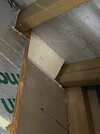Evening folks,
We've got a double garage that has had one side converted into habitable space (adjoining the house) and the loft above converted into a room with rear dormer - works were done c.2010 (before we bought the house), all signed off by building control, all finished to a decent enough standard inside.
Anyway, last winter the loft/dormer room was really cold so over summer I started doing a bit of investigation. To say that the overall insulation installation is a token effort would be an understatement! Hopefully the photos show what I mean.
So, the question is how to go about fixing this, ideally without completely stripping all plasterboard off the room as the quality of that bit seems fine. The floor installation appears to be mostly non-existent. The wall installation appears to be varying thickness PIR between studs, all being poorly fitted > plastic vapour barrier (but not everywhere) > some plasterboard backed with 20mm PIR (at least this bit seems to provide at least some continuous insulation), some standard. It may well be that once the floor is sorted the 20mm compensates at least a small amount for the gaps in the 90mm and the room is significantly warmer - not going to be as good as it could or should be though.
I can sort the floor easily enough - chipboard up, 100mm PIR with all gaps foam filled and then all joints foil taped with new chipboard down on top.
I can also get to the back of the 'dwarf' wall in the eaves and foam the gaps in the insulation from behind which will make some difference, however there doesn't appear to be a vapour barrier on this area as I can see the back of the plasterboard.
Where the insulation is fitted into the rafters, it appears to be right up against the roof felt, no gap for airflow.
And I've no idea what it's like in the timber frame dormer, but I imagine a similar sorry story!
So, with apologies for the rambling, any ideas?!
We've got a double garage that has had one side converted into habitable space (adjoining the house) and the loft above converted into a room with rear dormer - works were done c.2010 (before we bought the house), all signed off by building control, all finished to a decent enough standard inside.
Anyway, last winter the loft/dormer room was really cold so over summer I started doing a bit of investigation. To say that the overall insulation installation is a token effort would be an understatement! Hopefully the photos show what I mean.
So, the question is how to go about fixing this, ideally without completely stripping all plasterboard off the room as the quality of that bit seems fine. The floor installation appears to be mostly non-existent. The wall installation appears to be varying thickness PIR between studs, all being poorly fitted > plastic vapour barrier (but not everywhere) > some plasterboard backed with 20mm PIR (at least this bit seems to provide at least some continuous insulation), some standard. It may well be that once the floor is sorted the 20mm compensates at least a small amount for the gaps in the 90mm and the room is significantly warmer - not going to be as good as it could or should be though.
I can sort the floor easily enough - chipboard up, 100mm PIR with all gaps foam filled and then all joints foil taped with new chipboard down on top.
I can also get to the back of the 'dwarf' wall in the eaves and foam the gaps in the insulation from behind which will make some difference, however there doesn't appear to be a vapour barrier on this area as I can see the back of the plasterboard.
Where the insulation is fitted into the rafters, it appears to be right up against the roof felt, no gap for airflow.
And I've no idea what it's like in the timber frame dormer, but I imagine a similar sorry story!
So, with apologies for the rambling, any ideas?!



